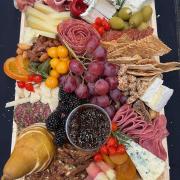A local caterer specializing in creating boards and grazing stations gave a presentation and demonstration on creating a charcuterie board. Following the lecture/demo, attendees could stay for a workshop and create their own board. Offering the workshop was a way to enhance the program as attendees had a chance to participate in a hands-on way with the presenter available to offer tips and help if needed.
Not everyone who came for the lecture and demo stayed for the workshop, which is what we anticipated.
To minimize the Library's cost for the program, attendees who stayed for the workshop were asked to bring a platter from home and some items from a shopping list (cheese, fruit, nuts, etc.) that the presenter provided to create their board. The shopping list was noted on our calendar.
Advanced Planning
Our goal was to provide a fun and informative event for our patrons while offering them the opportunity for lifelong learning — in this case, to leave with tips for creating their own charcuterie board for family and friends.
We had been floating this idea for some time, but finding a presenter was initially challenging. Through word of mouth, we found a caterer nearby who specialized in creating boards.
An additional challenge was how to offer the opportunity for attendees to make their own charcuterie board so that the program was more than just a lecture/demo. Purchasing food for everyone to create their own charcuterie board was cost-prohibitive. Once we found the presenter and determined we would ask those who wanted to stay for the workshop to bring their own supplies, we were ready to go!
The timeline for planning the program was no different from that of any of our other programs. Once the presenter was confirmed, we worked on creating publicity and promoting it in our usual channels.
We wanted to capitalize on the popularity of charcuterie boards, but the program's structure—a lecture and demo followed by a workshop—can be applied to many topics. It's a great way to enhance a program, offering patrons the opportunity for hands-on learning and the chance to incorporate tips learned from the lecture.
In fact, we did just that with a program on photo organizing that we presented early this year. A certified photo organizer presented a lecture on curating and organizing photos. Participants who were interested in putting the tips into practice stayed for the workshop following the lecture. They brought a box of photos and some minimal suggested supplies. The presenter was available to help and answer additional questions.
Marketing
We promoted the event through our usual channels: the Library's weekly enewsletter for several weeks leading up to the event, posters in the Library, and in the Library's designated pages of the city's newsletter, which is sent to every household and business in Highland Park.
The workshop had limited space (due to room capacity) and it filled with a waiting list.
Budgeting
The only cost associated with the program was an honorarium for the presenter. To avoid additional costs for the workshop portion of the event, we asked people to bring their own supplies (a platter and whatever items they wanted to include on their board: cheese, fruit, nuts, etc., based on a suggested shopping list the presenter provided).
We used this same model for a lecture and demonstration on flower arranging (Designer Hacks for Easy Fresh Flower Arranging). We offered a workshop following the program so that participants had a hands-on option to try the florist's tips with the florist providing help to those who stayed. Our typical programming budget wouldn't allow for us to purchase flowers for everyone so we asked participants to bring a small vase and flowers from home. The Library provided some flowers to supplement what people brought from home.
By asking participants to bring their own supplies, we avoid charging a fee for the program and we're able to offer something that would be beyond the Library's budget (purchasing charcuterie supplies or flowers, for example). We've found this model works well, allowing us options to extend the learning environment and enhance the program. We may offer the presenter an additional fee to stay for the workshop portion as the program is longer than our typical one-hour timeframe.
Day-of-event Activity
The set-up was typical for our programs—a table that the presenter used to demonstrate her work. The presenter brought all of the supplies and set up prior to the program. I was at the program to greet attendees, introduce the speaker, and oversee the program, but no additional staffing was needed.
Program Execution
Close to 50 attended the lecture/demo with close to 40 attending the workshop. The program attracted some women in their 30s and 40s (who came with friends). We don't usually see this age range in our programs. There was also a husband and wife who came together and stayed for the workshop, working on their board together.
Advice
We've found that offering a workshop following a lecture/demo enhances the program for those who want the opportunity for hands-on experience. It's a fun atmosphere that leads to camaraderie as everyone is working towards the same goal.
What's more, we've found that the model of asking attendees to bring their own supplies - whether it's meats and cheeses for a charcuterie board or flowers for a flower arrangement - works well. With our limited budget, it's a way to offer this enhancement to a typical lecture/demo without charging attendees for supplies.
Supporting Materials
- Feedback (Coming Soon!)
- Programming Librarian Facebook Group




